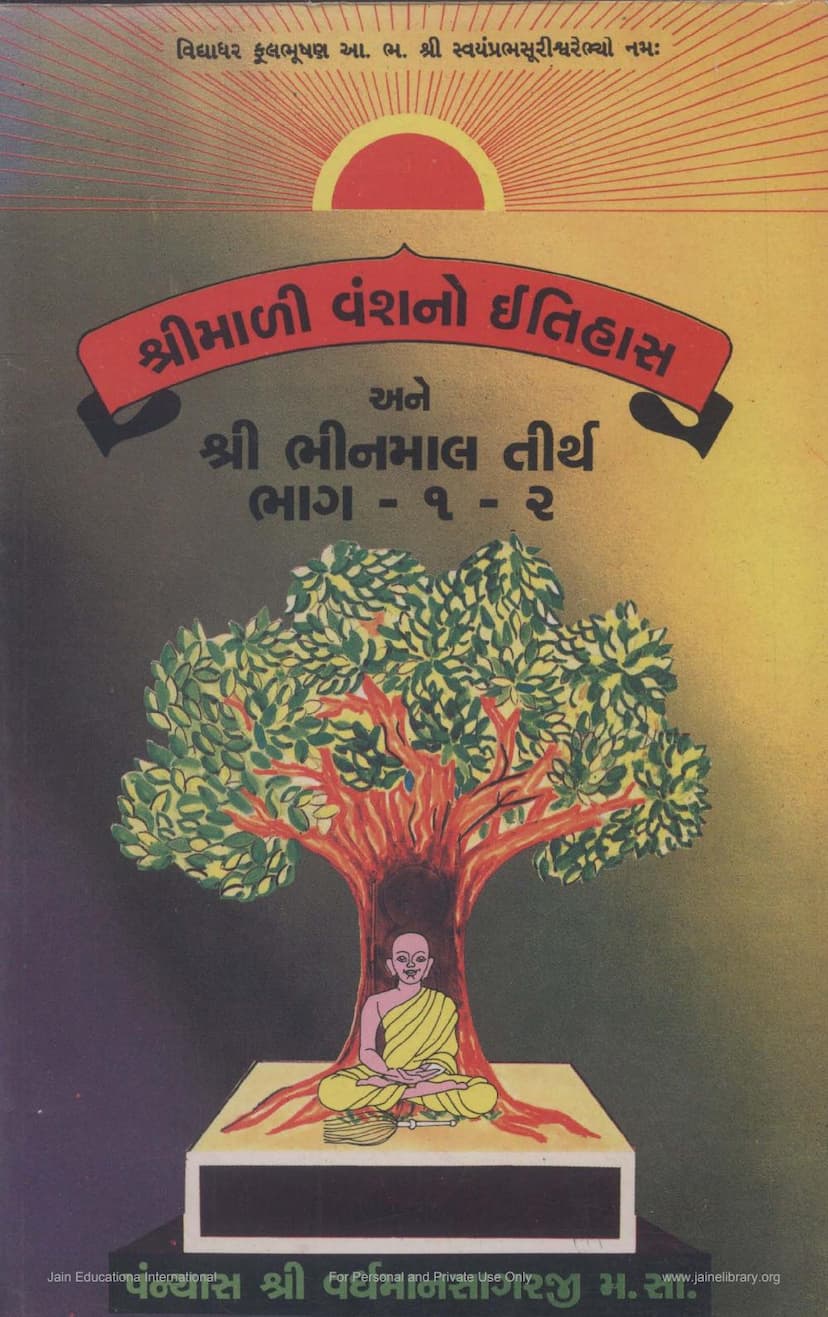Shrimali Vansh No Itihas Ane Bhinmal Tirth Part 1 Ane 2
Added to library: September 2, 2025

Summary
Here's a comprehensive summary of the Jain text "Shrimali Vansh no Itihas ane Bhinmal Tirth Part 1 ane 2" by Vardhamansagar, based on the provided pages:
This book, "History of the Shrimali Lineage and the Bhinmal Tirth (Parts 1 and 2)," compiled by Acharya Shri Padmasagarsurishwarji Gansar and written by Muni Vardhamansagar, aims to illuminate the history and significance of the Shrimali community and the ancient Jain pilgrimage site of Bhinmal.
Key Themes and Content:
-
The Shrimali Community:
- The book identifies the Shrimali community as one of the most ancient Jain castes, tracing its origins to the influence of Acharya Shri Swayamprabhsurishwarji in the city of Bhinmal (Shrimal) in Rajasthan.
- It highlights the significant contributions of the Shrimali community to Jainism, including the construction of temples, writing of scriptural texts, and their prowess in political, social, and trade spheres.
- The text explores the origins and evolution of the Shrimali caste, discussing their geographical movements (e.g., from Chandravati to various parts of Gujarat).
- It delves into the caste's structure, the reasons behind its formation, and the impact of historical events on its development.
- A significant portion is dedicated to the origin of surnames (ataks) within the Shrimali community, categorizing them based on ancestral names, village origins, and occupations. A substantial list of surnames is provided.
- The book also discusses the Dasha and Visha (or Vasha) classification within the Shrimali community, analyzing its historical roots and the evolution of these distinctions through inscriptions and community practices.
-
Bhinmal Tirth (Shrimal Tirth):
- Bhinmal, also known as Shrimal, is presented as a historically significant city and a sacred Jain pilgrimage site.
- The text traces the city's ancient history, mentioning its various names across different eras (Shrimal, Ratnamal, Pushpmal, Bhinmal) and its periods of prosperity and destruction.
- It highlights the presence of numerous Jain temples and the deep connection of the Shrimali community to this city.
- The book recounts the conversion of the city's inhabitants to Jainism under the guidance of Acharya Shri Swayamprabhsurishwarji, who established the "Mahajan Sangh" there.
- The text details significant events related to Bhinmal, including invasions, destructions, and reconstructions, underscoring its resilience and importance.
- It mentions historical figures associated with Bhinmal, such as the astronomer Brahmagupta and the poet Magha, as well as important Jain acharyas like Jinadas Gani, Udyotan Suri, and Siddharshi Gani, who had connections to the city.
- The book lists and describes various Jain temples and sites within Bhinmal, providing details about their history, inscriptions, and associated figures.
-
Jain Kings and the Spread of Jainism:
- The text emphasizes that Jainism was not solely a religion of traders (Vaishyas) but was also embraced by Kshatriyas (warriors) and kings. It cites examples of Jain kings and their patronage of Jainism, demonstrating its wide appeal.
- The book touches upon the history of Jain gacchas (sects or lineages) and their role in spreading Jain principles.
-
The Role of Acharyas and Religious Leaders:
- The work pays homage to prominent Jain Acharyas, particularly Acharya Shri Swayamprabhsurishwarji and Acharya Shri Padmasagarsurishwarji, acknowledging their spiritual guidance and contributions.
- It also lists the spiritual lineage of Acharya Shri Buddhisagarsurishwarji, including both monks and nuns.
- The book highlights the dedication and efforts of the author, Muni Vardhamansagar, and the compiler, Acharya Shri Padmasagarsurishwarji, in bringing this work to fruition.
-
Social and Cultural Aspects:
- The text touches upon ancient Indian social structures (the four varnas) and how these evolved over time, leading to the formation of castes and sub-castes.
- It discusses the influence of religious movements like Buddhism and Jainism on societal norms and the eventual revival of Vedic traditions.
- The concept of "Jati" (caste) is explored, explaining its origin in social regulations and marriage practices.
-
Key Historical Figures:
- The book highlights the generosity and piety of figures like Vastupal and Tejpal, renowned patrons of Jainism, detailing their extensive charitable works and temple constructions.
- It also includes a brief biographical sketch of Shri Tilchandji, a devout individual who contributed to religious activities.
-
Philosophical and Ethical Reflections:
- The book includes a section of "Thought-Provoking Sayings" (Vicharaniya Vakyo) that offer spiritual and ethical guidance, emphasizing concepts like non-violence, truth, detachment, the importance of good deeds, and the nature of true happiness.
-
Inscriptions and Epigraphy:
- A significant portion of the book is dedicated to presenting and analyzing ancient Jain inscriptions found on statues and temples, primarily from the 15th to 19th centuries. These inscriptions provide crucial evidence for the history of various Jain communities, including the Shrimalis, Porwads, and Oswals, and their religious practices.
In essence, "Shrimali Vansh no Itihas ane Bhinmal Tirth" is a scholarly and devotional exploration of the history of the Shrimali Jain community and the ancient Jain center of Bhinmal. It serves as a vital resource for understanding Jain heritage, social evolution, and the enduring legacy of faith and patronage.